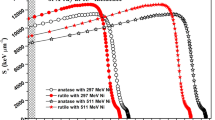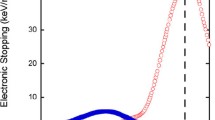Abstract
The existing descriptions of the process of track formation in metals bombarded with high-energy heavy ions are usually based on the T-spike model. However, this model fails to explain high temperatures developed in some target materials (e.g., in copper). We present a comparative analysis of track formation in metals under the action of heavy ion bombardment, as described using the Coulomb explosion model and the T-spike model in various modifications. Both models are used to calculate changes in the temperatures of the electron and ion subsystems in the track region in amorphous alloy Fe85B15) and copper targets bombarded with identical high-energy (E > 1 MeV/nucleon) heavy ions. The results show that the Coulomb explosion model predicts stronger heating of the ion subsystem in the track region (with the possible formation of a melt-through zone) as compared to the T-spike model. The formation of point defects in copper as a result of the ionization losses has been also described using the two models and compared to the available experimental data. The Coulomb explosion model provides for a more adequate description of track formation as compared to the T-spike model.
Similar content being viewed by others
References
C. Dufour, Commissariat L’energie atomique, Service de documentation et D’edition multimedia (France), CEA-R-5638.
K. Yasui, Nucl. Instrum. Methods Phys. Res. B 90, 409 (1994).
E. V. Metelkin and A. I. Ryazanov, Zh. Éksp. Teor. Fiz. 117, 420 (2000) [JETP 90, 370 (2000)].
A. Iwase, T. Iwata, and T. Nihira, J. Phys. Soc. Jpn. 61, 3878 (1992).
J. M. Ziman, Electrons and Phonons (Clarendon, Oxford, 1960).
Y. S. Touloukian and E. H. Buyco, Thermophysical Properties of Matter, Vol. 4: Specific Heat (IFI/Plenum, New York, 1970).
Y. S. Touloukian, R. W. Powell, C. Y. Ho, and P. G. Klemens, Thermophysical Properties of Matter, Vol. 1: Thermal Conductivity (IFI/Plenum, New York, 1970).
M. Toulemonde and C. Dufour, Phys. Rev. B 46, 14362 (1992).
Yu. V. Martynenko and Yu. N. Yavlinskii, Dokl. Akad. Nauk SSSR 270, 88 (1983) [Sov. Phys. Dokl. 28, 391 (1983)].
I. M. Lifshits, M. I. Kaganov, and L. V. Tanatarov, Zh. Éksp. Teor. Fiz. 31, 232 (1956) [Sov. Phys. JETP 4, 173 (1956)].
Author information
Authors and Affiliations
Additional information
__________
Translated from Zhurnal Éksperimental’no\(\overset{\lower0.5em\hbox{$\smash{\scriptscriptstyle\smile}$}}{l} \) i Teoretichesko\(\overset{\lower0.5em\hbox{$\smash{\scriptscriptstyle\smile}$}}{l} \) Fiziki, Vol. 128, No. 1, 2005, pp. 139–149.
Original Russian Text Copyright © 2005 by Ryazanov, Pavlov, Metelkin, Zhemerev.
Rights and permissions
About this article
Cite this article
Ryazanov, A.I., Pavlov, S.A., Metelkin, E.V. et al. Effect of Coulomb explosion on track formation in metals irradiated by heavy ions. J. Exp. Theor. Phys. 101, 120–127 (2005). https://doi.org/10.1134/1.2010668
Received:
Issue Date:
DOI: https://doi.org/10.1134/1.2010668




